Picturing art's past
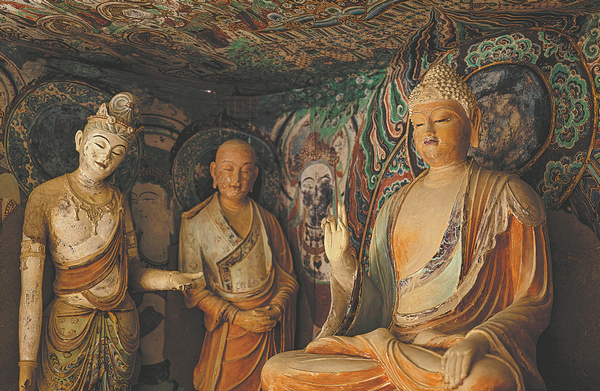
Some replicas of stone statues from the Mogao Caves in Dunhuang, Gansu province, are shown at an exhibition, which opened on March 10, at the Zhejiang Art Museum in Hangzhou, Zhejiang province. WANG JINCHAO/FOR CHINA DAILY
Cutting-edge technology enables precious paintings to be examined without fear of damage, report Ma Zhenhuan and Qi Xiao in Hangzhou.
As the focus of the visitor's eyes moves, the scroll of A Panorama of Rivers and Mountains, one of the best-known Chinese landscape paintings by artist Wang Ximeng of the Song Dynasty (960-1279), unfurls. Standing in front of Emperor Minghuang's Journey to Shu, painted by artist Li Zhaodao of the Tang Dynasty (618-907), visitors might be forgiven for thinking that they have stepped into the emperor's world.
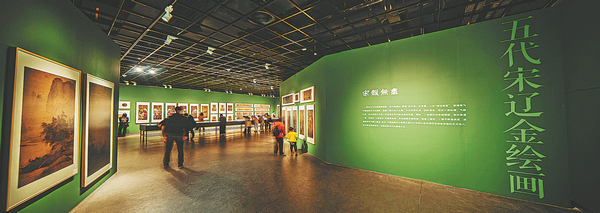
Visitors enjoy prints of ancient Chinese paintings on the exhibition's opening day. WANG JINCHAO/FOR CHINA DAILY
Eye tracking and 3D video are among the myriad interactive and immersive technologies used in an exhibition at the Zhejiang Art Museum in Hangzhou, capital city of East China's Zhejiang province. Among the high-tech features are motion capture as well as augmented and virtual reality.
"Smart technology is a fundamental starting point for the exhibition, as we aim to make it more accessible and attractive, especially to the younger generation," says Wang Xiaosong, vicedean of the School of Art and Archaeology at Zhejiang University and co-curator of the exhibition. On show are some 1,500 prints of ancient Chinese paintings from the pre-Qin period (before 221 BC) to the Yuan Dynasty (1271-1368).
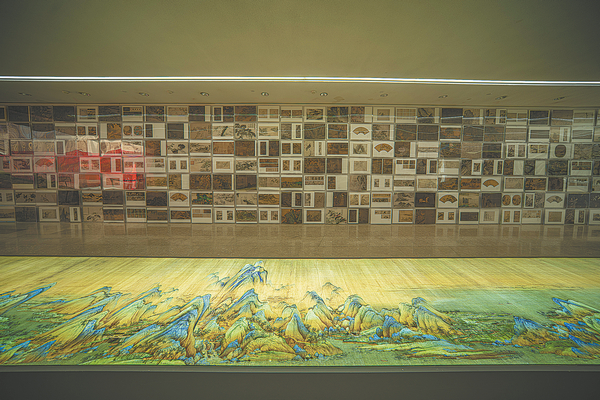
A reproduction of the scroll, A Panorama of Rivers and Mountains. WANG JINCHAO/FOR CHINA DAILY
The exhibition, being held from March 10 until April 20, is based on a national cultural and publishing project that has been running for 17 years. Over that period, art historians have established a digital archive of 12,479 ancient Chinese paintings from the pre-Qin period to the late Qing Dynasty (1644-1911), canvassing more than 260 cultural institutions and museums around the globe and making it the most complete collection of its kind.
The project marks one of the most comprehensive efforts by any country to systematically examine its paintings throughout history and digitalize all of the surviving ones with a view to publishing the results. "Now we are sharing the 'fruits' of this labor with the public," says Ying Jinfei, the other co-curator of the exhibition.
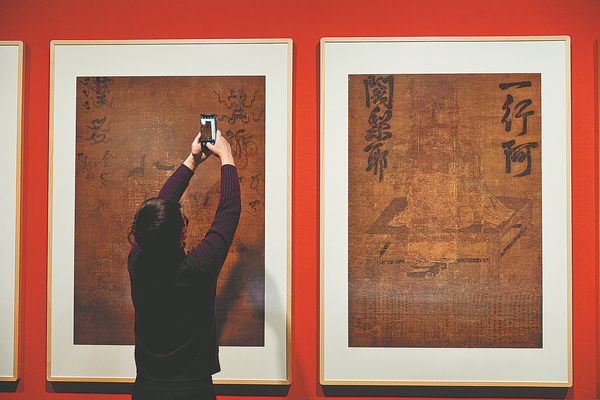
A visitor photographs a print of a Tang Dynasty (618-907) painting.LIU WEIJIE/FOR CHINA DAILY
"The breadth and depth of the project will help the public gain a much deeper understanding of traditional Chinese arts through exhibitions like this," says Ying, who is also head of the Zhejiang Art Museum.
"The more people can learn and appreciate traditional Chinese paintings, the more it will help 'bring them to life'," says Ying, echoing China's efforts in recent years to renew its traditions and carry forward its cultural heritage.
The advancement of technology has played a pivotal role in the process. For example, the result of the digitalization and publication project has proved to be a boon to Chinese arts scholars and students, as state-of-the-art digital technology is able to restore every minute detail of the paintings. Instead of relying on the originals, they can now easily turn to these high-quality images for their research.
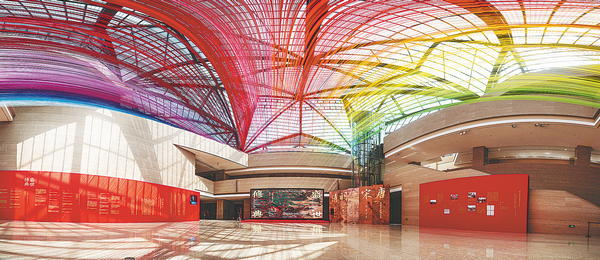
A view of the exhibition hall. WANG JINCHAO/FOR CHINA DAILY
The classic dilemma between preservation and exhibition, as well as application, is perfectly resolved, according to Li Zhirong, a professor at Zhejiang University's School of Art and Archaeology and also deputy director of its Cultural Heritage Research Institute.
"For a long time, we needed to maintain a delicate and difficult balance between conserving cultural relics and putting these treasures on public display or making them available for research," Li explains. "On the one hand, we don't want to cause any permanent damage, but on the other, we would like the public to enjoy them as much as possible."
Using the latest 3D laser scanning, modeling, photogrammetry and printing technology, her team has produced full-scale mobile replicas of some of the stone caves from China's most well-known grottoes, including Dunhuang, Yungang and Longmen, respectively in Gansu, Shanxi and Henan provinces, and brought them to the exhibition.
"You can appreciate the finest details in these reconstructed caves, and you don't even have to travel far," Li says.

Over 1,500 prints of ancient Chinese paintings are on display at the exhibition. WANG JINCHAO/FOR CHINA DAILY
While technology is definitely revolutionizing the way people experience traditional Chinese arts and culture, their unique development pattern is believed to have been the key to its continued vitality.
"Chinese arts and culture have been in constant dialogue with their history, making progress by building upon their past," says Gao Shiming, an internationally renowned art scholar and president of China Academy of Art. "That's why many of the nation's artistic and cultural traditions are still very much alive today."
Ultimately, these rich artistic and cultural traditions, and their heritage, are not just China's wealth, but belong to humanity, Gao adds. "They will be a cornerstone for the building of a community with a shared future for mankind."
Contact the writers at mazhenhuan@chinadaily.com.cn


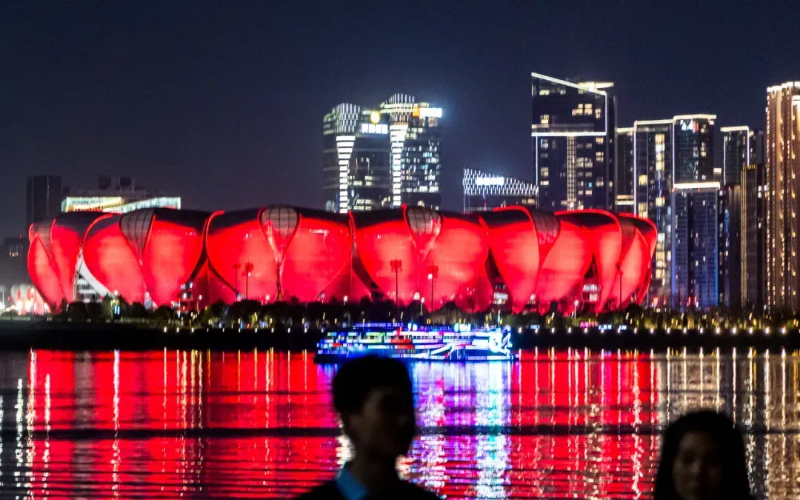

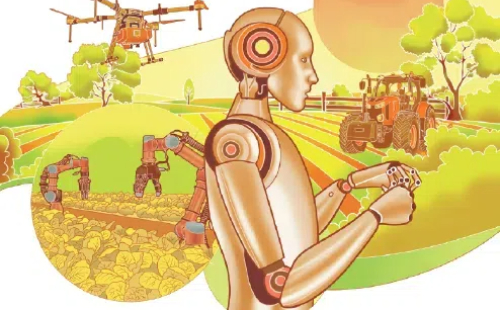
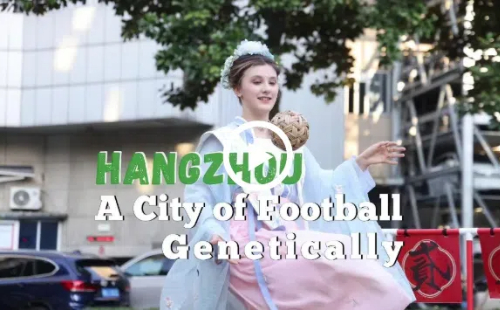 play
play